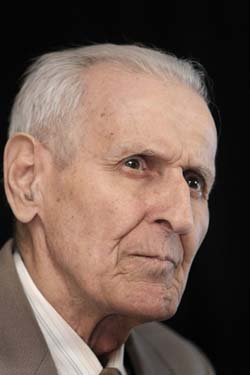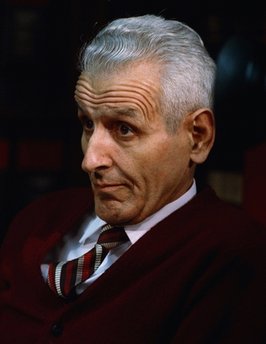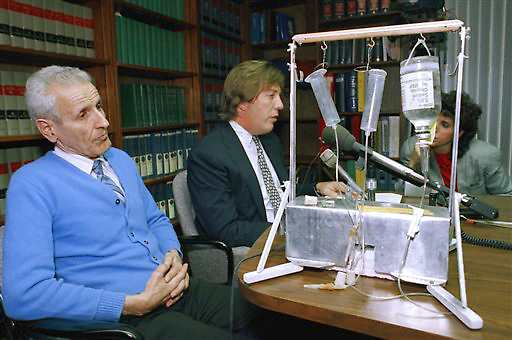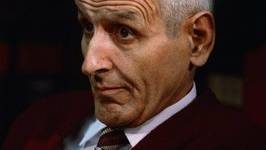"Dr. Death", Kevorkian dies at 83
Source: news.yahoo.com
 Jack Kevorkian built his suicide machine with parts gathered from flea markets and stashed it in a rusty Volkswagen van.
Jack Kevorkian built his suicide machine with parts gathered from flea markets and stashed it in a rusty Volkswagen van.But it was Kevorkian’s audacious attitude that set him apart in the debate over doctor-assisted suicide. The retired pathologist who said he oversaw the deaths of 130 gravely ill people burned state orders against him, showed up at court in costume and dared authorities to stop him or make his actions legal. He didn’t give up until he was sent to prison.
The 83-year-old Kevorkian died Friday at a Michigan hospital without seeking the kind of "planned death" that he once offered to others. He insisted suicide with the help of a medical professional was a civil right.
His gaunt, hollow-cheeked appearance gave him a ghoulish, almost cadaverous look and helped earn him the nickname "Dr. Death." But Kevorkian likened himself to Martin Luther King and Gandhi and called physicians who didn’t support him "hypocritic oafs."
"Somebody has to do something for suffering humanity," he once said. "I put myself in my patients’ place. This is something I would want."
Kevorkian jabbed his finger in the air as he publicly mocked politicians and religious leaders. He was a magnet for the news media, once talking to reporters with his head and wrists restrained in a medieval-style stock.
His efforts put the medical establishment in knots: Here was a doctor admitting he had helped people die and urging others in the profession to do the same.
Kevorkian died at William Beaumont Hospital in Royal Oak, where he had been hospitalized since May 18 with pneumonia and kidney problems. He suffered from a blood clot that traveled up from his leg, according to attorney Mayer Morganroth, who was present and said his friend was "totally in peace, not in pain."

In this Dec. 3, 1990 file photo, Dr. Jack Kevorkian sits in his lawyer’s office in Southfield, Mich., after Oakland County Prosecutor Richard Thompson announced that he would be charged with murder in the death of a woman who committed suicide by using a device of the doctor’s.
"His medical directive was not to be given any CPR or continuing life program." Morganroth said.
Kevorkian’s flamboyant former attorney, Geoffrey Fieger, believes Kevorkian would have taken advantage of doctor-assisted suicide if it had been available.
"If he had enough strength to do something about it, he would have," Fieger said Friday. "Had he been able to go home, Jack Kevorkian probably would not have allowed himself to go back to the hospital."
The former prosecutor whose office convicted Kevorkian of second-degree murder said he found a trace of hypocrisy in Kevorkian’s death.
"I assumed that someday he’d commit suicide and tape it and air it for the world to see," said David Gorcyca, who oversaw prosecutions in the Detroit suburbs of Oakland County.
Despite Kevorkian’s relentless efforts in the 1990s, few states made physician-assisted suicide legal. Laws took effect in Oregon in 1997 and Washington state in 2009, and a 2009 Montana Supreme Court ruling effectively legalized the practice in that state.
L. Brooks Patterson, another former prosecutor and the county executive in Oakland County, described Kevorkian as an "affable guy" but said his tactics hurt his cause.
"I don’t think he was the right ambassador to represent the issue," Patterson said. "It was the law be damned with him. The issue would have been better debated in a more serious arena than in the back of Jack’s van. ... It was a sideshow. Helping people commit suicide in the back of a van is not dying with dignity."
Those who sought Kevorkian’s help typically suffered from cancer, Lou Gehrig’s disease, multiple sclerosis or paralysis.
He catapulted into the public eye in 1990 when he used his machine to inject lethal drugs into an Alzheimer’s patient. He often left the bodies at emergency rooms or motels.

In this Feb. 6, 1991 photo, retired Royal Oak, Mich. pathologist, Dr. Jack Kevorkian, left, listens as his attorney, Geoffrey N. Fieger, talks with reporters, after return of the Suicide Machine. Photo: AP
For much of the decade, he escaped legal efforts to stop him. His first four trials, all on assisted-suicide charges, resulted in three acquittals and one mistrial. Murder charges in Kevorkian’s first cases were thrown out because Michigan had no law against assisted suicide. The Legislature wrote one in response. He also was stripped of his medical license.
Devotees filled courtrooms wearing "I Back Jack" buttons. Critics questioned his headline-grabbing methods, which were aided by Fieger, until the two parted ways before the 1999 trial in which he was sent to prison for eight years.
"The issue’s got to be raised to the level where it is finally decided," Kevorkian said during a broadcast of CBS’ "60 Minutes" that aired the videotaped death of Thomas Youk, a 52-year-old man with Lou Gehrig’s disease.
He challenged prosecutors to charge him again, and they obliged with second-degree murder charges.
Kevorkian acted as his own lawyer. In his closing argument, he said some acts "by sheer common sense are not crimes."
"Just look at me," he told jurors. "Honestly now, do you see a criminal? Do you see a murderer?"
Kevorkian’s ultimate goal was to establish "obitoriums" where people would go to die. Doctors there could harvest organs and perform medical experiments during the suicide process. Such experiments would be "entirely ethical spinoffs" of suicide, he wrote in his 1991 book "Prescription: Medicide — The Goodness of Planned Death."
In a rare televised interview from prison in 2005, Kevorkian told MSNBC he regretted "a little" the actions that put him there.
"It was disappointing because what I did turned out to be in vain. ... And my only regret was not having done it through the legal system, through legislation, possibly," he said.
Kevorkian was freed in June 2007 after serving eight years of a 10- to 25-year sentence. His lawyers said he suffered from hepatitis C, diabetes and other problems, and Kevorkian promised in affidavits that he would not assist in any more suicides if released.
Tina Allerellie became a fierce critic after her 34-year-old sister, Karen Shoffstall, turned to Kevorkian in 1997. She said Shoffstall, who suffered from multiple sclerosis, was struggling with depression and fear but could have lived for years longer.
Kevorkian’s intent "has always been to gain notoriety," Allerellie said in 2007.
In 2008, Kevorkian ran for Congress as an independent, receiving just 2.7 percent of the vote in his suburban Detroit district. He said his experience showed the party system was "corrupt" and "has to be completely overhauled."
Born in 1928, in the Detroit suburb of Pontiac, Kevorkian graduated from the University of Michigan’s medical school in 1952 and went into pathology.
He said he first became interested in euthanasia during his internship year when he watched a middle-aged woman die of cancer. She was so emaciated, her sagging, discolored skin "covered her bones like a cheap, wrinkled frock," Kevorkian wrote.
On June 4, 1990, he drove his van to a secluded park north of Detroit. After the Alzheimer’s patient, 54-year-old Janet Adkins of Portland, Ore., met him there, he inserted a needle into her arm. When she was ready, she flipped the switch that began a flow of lethal drugs.
He later switched from his device to canisters of carbon monoxide, again insisting patients take the final step by removing a clamp that released the deadly gas to a face mask.
Kevorkian’s life story became the subject of the 2010 HBO movie "You Don’t Know Jack," which earned actor Al Pacino Emmy and Golden Globe Awards for his portrayal of Kevorkian. Pacino paid tribute to Kevorkian during his Emmy acceptance speech and recognized the former doctor, who sat smiling in the audience.
Pacino said during the speech that it was a pleasure to "try to portray someone as brilliant and interesting and unique" as Kevorkian and a "pleasure to know him."
Kevorkian himself said he liked the movie and enjoyed the attention it generated. But he doubted it would inspire much action by a new generation of assisted-suicide advocates.
"You’ll hear people say, `Well, it’s in the news again, it’s time for discussing this further.’ No, it isn’t. It’s been discussed to death," he told The Associated Press. "There’s nothing new to say about it. It’s a legitimate, ethical medical practice as it was in ancient Rome and Greece."
Read the full article at: news.yahoo.com
Top Image: Jack Kevorkian, 79, looks on as he discusses his decision to run for Congress at a news conference March 24, 2008 in Southfield, Michigan. Kevorkian served eight years in prison after he was convicted in 1999 of second degree murder for assisting in the suicide death of a man who had Lou Gerhig’s disease.
(March 23, 2008 - Photo by Bill Pugliano/Getty Images North America)
Video from: YouTube.com
Video from: YouTube.com






















